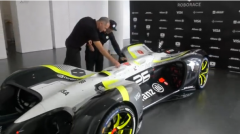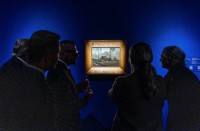
BARCELONA, Spain (Reuters) — The team behind the world’s first driver less electric racing series unveiled its first real autonomous car at the World Mobile Congress (MWC) in Barcelona on Monday (February 27).
The sleek Roborace vehicle is around five meters long, two meters wide, and weighs in at 975 kilograms. It is entirely driver less, with a computer “brain” using information from sensors to direct the Robocar.
It has four motors of 300kW each, a 540kW battery, and is mostly made of carbon fiber.
Its sensors include five lidars (light detection and ranging sensors), 18 ultrasonic sensors, a global navigation satellite system and six artificial intelligence cameras.
Its developers say Robocar can reach speeds of more than 320 kilometers per hour.
Designer Daniel Simon, who was behind the production of vehicles used in Hollywood films like Tron Legacy, said the shape of the car is key.
“They go over 320 kilometers per hour, these are monsters, you know. They are scary, they are fast, they are powerful. There is so much air pushing through here when it moves at speed, we need every little part to do aerodynamic work. This whole body pushes the car on the ground – it can literally drive on the roof,” he said at the MWC launch.
Roborace CEO Denis Sverdlov told Reuters the company was pioneering new driver less technology that would one day be used on roads.
“We believe the future of all automotive industry is going to be driver less, electric and connected. The racing environment has always been the place where advanced technologies were tested and developed and now Roborace is going to be the place where this technology is going to be developed and tested for the future of the automotive industry,” he said.
The futuristic look of the car was determined by the technology, said Simon.
“The things we could not choose really is where the sensors go. There’s no human in there so we need eyes, ears and the big ones are the five lidars. What’s important is they have to overlap in the view angles; there cannot be any blind spots, so this is very particular, how they are placed, which was stylistically rather challenging because ideally I wanted it to be very thin and elegant,” he said.
The car’s “driver” is the Nvidia Drive PX2, which Roborace says is capable of up to 24 trillion AI operations per second and is an open AI platform to be programmed by software engineers using complex algorithms.
Roborace plans to provide the same hardware to developers for its racing car to ensure it is the driverless technology software that is competing on the track.
Sverdlov envisages road cars employing the very same technology in the future.
“You need to be not only very fast, but you also need to be smart, so you need to avoid collisions. All the algorithms which will be created here for collision-avoidance in extreme conditions will be used in the road cars,” he explained. “If you ask people right now will they accept robots on the roads, you probably would hear ‘no’, and we believe Roborace will be a platform which will help people to understand how this technology works.”
Robocar showcased the first run of its two driverless development, or ‘DevBot’, electric cars on February 18 in Buenos Aires, Argentina.
The two cars ran on track together at speeds of up to 185kph but mostly slower, using sensors and onboard systems to navigate the street circuit used by the Formula E series.
The DevBots communicated with each other to avoid contact but one of the two still crashed into barriers.
A stray dog on the track posed an additional hazard.
Formula E organizers hope ultimately to have up to 10 driverless cars racing together, run by teams who write their own software, around city tracks, as a support event to their series.







